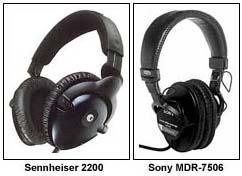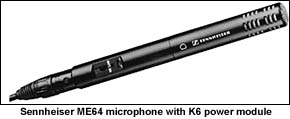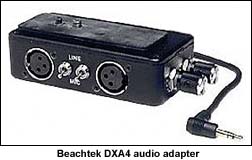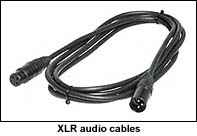|
Martha
Smith The Must-Have's |
 |
|
At the Platypus workshop in Oklahoma City, one FAQ was "How much does a good audio package cost?" I can't give you an exact dollar figure, but I do know what buys are must-haves and I'll give you market pricing. You do your own math.
Two good headset options are Sennheiser's Evolution series EH 2200 and Sony's MDR 7605 (each around $100). Each of these is wired to a stereo mini-jack, which will allow you to listen to each camera audio channel independently. Very important.
As for a way to mount a professional mic on your camera, here's what I know. Some cameras come with a built-in mic holder; most do not. Videosmith sells a number of Mightywondercam products which have a threaded adapter for mounting a microphone next to the camera. But if you're mounting a mic directly on the camera, you'll probably be using the shoe adapter. A good shoe-adapter mic mount is hard to find. I've been looking. They do exist, but you really want a shoe-adapter shockmount if you're putting a mic directly onto the camera. A shockmount is a mic mount with shock-absorbing material between the base and the mic. A shockmount is essential for mounting a mic to a mobile platform (like a camera or handgrip) because it isolates handling noise, and prevents it from being transmitted to the mic.
Back to microphones. I've recorded audio onto a lot of different media in 27 years. But I've used the same mic techniques, and pretty much the same microphones all those years. My microphone complement is a "shotgun" and a lavalier. "Lavs" are small mics that you clip on to a person's clothing for an interview. The "shotgun" mic is a specialized version of the handheld "stick" mic. It is designed to produce good voice pickup at a distance greater than a foot (therefore, out of the shot). A professional "short shotgun" is an extremely versatile mic, and the must-have I recommend for your list of audio investments. There was confusion among Platypi about the terms "balanced" and "unbalanced" as they relate to audio products. It turns out that 99.9% of the world's population is confused about these terms. Why should we even care about balanced and unbalanced connections? Because most professional audio products use 3-pin, balanced XLR connections, and yet we live in a world of consumer audio products which have unbalanced connections (often a 2-pin mini or an RCA). Even some companies offering professional products (Canon, Sennheiser) use unbalanced connections (GL1, EV-100 wireless system). A balanced connection uses mic conductors in a way that blocks electrical noise, allowing a clean audio signal to pass through the system. This is not done in an unbalanced connection, which makes the mic signal more susceptible to unwanted noise. For more information, go to www.dplay.com/dv/balance/balance.html. Now, having said all this, balanced/unbalanced is more of an issue for folks using lengthy mic cable runs than it is for us. There are the odd impedance concerns too, but leave these for the engineers. The professional shotgun microphones I've used for 27 years have been Sennheisers, starting with the 805 (LONG microphone - 24'' tube), and going to the shorter 416, and MKH 60. I've never been disappointed by Sennheiser's mics; they are truly good investments - the ones you'll still be using when you're on your fifth camera. These are condenser mics, meaning you need a power supply for them. Sennheiser makes the modular K6 Series of mics, which are powered by a built-in AA battery. This is a capsule system, which means you buy the power/electronics module (K6) and screw on the desired capsule type. There are two short shotgun capsules - the ME 64 and the ME 66. The ME 64 has a classic "cardioid" pattern, which means that the audio "pick-up" pattern is a wide heart shape with the bottom of the heart starting at the front tip of the mic. Audio to the side of the mic is suppressed rather than rejected, so you'll pick up voices close to the camera, and in front of the lens 3-6 feet away. It's ideal for use by a cameraperson who likes to shoot in the middle of the crowd or at the edge of the action. The ME 66 has a long and narrow heart-shaped ("super-cardioid") pickup pattern. There is greater rejection of audio to the side of the mic, but audio pickup at a greater distance than with the ME 64. It's a far better choice for shooting action across a stream, or for picking up conversations across an aisle in the farmers' market. Used directionally from the camera straight-on to a speaker, you'll get good voice pickup at 5-8 feet with the ME66. These mics can be used off the camera for an interview. Since the ME 64 would be best positioned 18-24'' away from your subject, you'd probably use it handheld. An ME 66, however, would be best positioned 24-30'' away from your subject. In this instance, you would most likely mount the mic on a clamp. Remember, these are directional mics, so make sure the front tip of the mic is aimed generally at the desired source of audio. The K6 Series mics are pricey. The ME 64 package (K6, 64 capsule, mic holder) costs $450; the ME 66 package costs $470. The beauty of buying this system, however, is that once you've invested in the battery/electronics module, you can buy other capsules for it. An ME 64 capsule by itself lists at $200; an ME 66 capsule lists at $250. You can even buy a lavalier capsule which many folks use (and one I really like) - one of the MKE series - for $350. Of course, if you want to use both the lav and the short shotgun at the same time (which makes perfect sense), you'll need an extra K6 ($285). So now, you're looking at a GREAT complement of mics, but MEGA bucks. My advice: Invest in an expensive short shotgun. (I think the ME66 is the more versatile of the two, but talk to people who use mics like these before you buy.) Then, look around for a used lavalier, being sold by a reputable person who is upgrading (try eBay). Sony's ECM 55 is a very good mic, but just a little larger than most people use these days. You should be able to find a black one, well-taken-care-of, for less than $150. Use it in conjunction with your splendid short shotgun, Beach box, and isolation headsets, and you've got yourself an audio package. Well, almost. You'll need a windscreen for your shotgun. Most people buy those boring, standard grey foam ones. The reason is that they do a good job for the price. If you are shooting anything outdoors, it's important to use the windscreen. Most people keep one on the mic all the time, even indoors. That's not necessary from an audio point-of-view, but it's not especially harmful either. What is harmful is not rinsing out your windscreen occasionally. Grit and dirt blocking the foam pores will prevent the audio from getting to your expensive mic, which has been carefully engineered for optimum sound. The boring foam windscreens will cost $24 for the ME 64, and $39 for the ME 66. For a little more money ($33 and $69, respectively), you can buy a black velour windscreen. I haven't used one of these, so I can't say if it works any better, but it looks a whole lot nicer. You may want to choose this option if you anticipate that your mic will appear in the shot frequently. If you're working on those breezy prairies, you may need something more than just a foam windscreen to block the gusts. I've put my sweatshirt sleeve over the foam for extra protection in those situations. The wind gust protection of choice of those clever soundpersons of yore was a silk stocking. You can cover the foam, or you can change to a heavier-duty windscreen. Lightwave makes a wide range of windscreens, which many folks with sterling audio credentials swear by. Go to www.lightwavesystems.com for lots of interesting reading. If I were traveling versatile but light, I'd always have a Rowi clamp, gooseneck (or as the Germans translate it into English, a "swan neck") and a 25' XLR cable with me. You all have plenty of experience using clamps so I won't say anything more about them, except that I just saw the Rowi with the optional feet - cool, and perfect for the mic on the table at the press conference. Put a 12'' black "swan neck" (about $15) on your Rowi, and clamp it to something; put your short shotgun in its shockmount on the other end of the swan neck; get the audio back to the Beach box with your nice (say, purple) 25' XLR cable. And Presto! you are ready to record an interview or a chamber music ensemble. The swan neck taken off the Rowi will double as an arm extender/hand grip when the short shotgun is used handheld. I never leave home without spares. I would advocate having two 25' XLR cables in your kit, and a versatile "run & gun" mic when all else fails. At the Platypus session in Oklahoma City, we talked about old-technology dynamic (unpowered) mics. Rugged, handheld, omnidirectionals, such as the EV (Electrovoice) 635A are essentially bulletproof. There was some question about whether or not this mic would work with a new-technology camera. It does, I tried it. The old tech EV 635A can be purchased in nouveau black for a little more than $100. For interviews it's probably going to end up in the shot - you'll want to hold it 12-15'' away from the voice. But it's rugged, wind-resistant, and unfazed by loud noises, which makes it perfect for miking the stadium implosion, or really LOUD music up close to the speakers. When I do the math for the market basket of audio must-haves, I get a total of $1250. That's $750 in mics - ME 66 package with windscreen, EV 635A, a used ECM 55; and $500 for the supporting gear - headsets, Beachtek's DXA, 3 XLR cables, a Rowi clamp, a gooseneck, and shockmount. An experienced audio-recordist friend of mine just put together an audio package for a miniDV project he's working on. His market basket total was $900, the difference being his choice of mics. He and his mates decided they couldn't use a wired lavalier, since their subject moved around a lot, and they couldn't afford to buy a wireless mic system. So he opted for a used 635A and a long shotgun mic (an Audio Technica). No matter what complement of microphones you buy, if you aim for a versatile kit you'll be able to do quality audio recording in almost any situation for a long time, before you have to start thinking about buying anything else. Can you say that about those mighty, little cameras? Next time, we'll get into how to buy and use radio mics and some other audio tips.
|
|
ARCHIVES
| PORTFOLIOS
| LINKS |
|
Read
Steve Smith's previous columns |
 To
get out on location and start recording quality audio with your new,
wonderful little camera, there are three must-haves. The first must-have
is a pair of isolation headsets. And I mean isolation. You must
be able to hear the audio coming from the mic to the exclusion of all
other sounds. I've had plenty of experiences where I've heard things
on location through the mic and headsets, that people standing next
to me never heard with their ears. I've also had plenty of experiences
where cameraman Steve (sans headsets) will report that our subject said
thus-and-so, but I never heard it on the headsets, "Did you get that
audio?" You'll never know, unless you're wearing headsets which allow
you to hear only the sound coming through the mic.
To
get out on location and start recording quality audio with your new,
wonderful little camera, there are three must-haves. The first must-have
is a pair of isolation headsets. And I mean isolation. You must
be able to hear the audio coming from the mic to the exclusion of all
other sounds. I've had plenty of experiences where I've heard things
on location through the mic and headsets, that people standing next
to me never heard with their ears. I've also had plenty of experiences
where cameraman Steve (sans headsets) will report that our subject said
thus-and-so, but I never heard it on the headsets, "Did you get that
audio?" You'll never know, unless you're wearing headsets which allow
you to hear only the sound coming through the mic.  The
second must-have is a versatile microphone, which can be
mounted on the camera, but which can also be used away from the camera
as a remote mic (handheld for an interview, for example). You'll most
likely replace the mic that comes with the camera. The usual replacement
is a "short shotgun" type. A professional mic has a male 3-pin XLR plug
output, which means you'll need a short mic cable, with XLR connectors,
to route the mic signal to the camera. You'll also need a long XLR mic
cable to remote the mic some distance from the camera. And you'll need
a way to hold the mic either on the camera or away from it. I'll get
into mic specifics in a minute, but this brings me to...
The
second must-have is a versatile microphone, which can be
mounted on the camera, but which can also be used away from the camera
as a remote mic (handheld for an interview, for example). You'll most
likely replace the mic that comes with the camera. The usual replacement
is a "short shotgun" type. A professional mic has a male 3-pin XLR plug
output, which means you'll need a short mic cable, with XLR connectors,
to route the mic signal to the camera. You'll also need a long XLR mic
cable to remote the mic some distance from the camera. And you'll need
a way to hold the mic either on the camera or away from it. I'll get
into mic specifics in a minute, but this brings me to... The
third must-have is a device which connects XLR mic cables to the camera
audio input. Sony's PD150 camera comes with XLR audio inputs, and
Canon offers an XLR adapter (MA100) for the XL1. But, most miniDV cameras
have a stereo-mini input. The only sane way to get an XLR mic feed into
a stereo mini-audio input, is to use a device like the Beachtek DXA
(for Dual XLR Adapter). Harry Kaufmann has designed this nifty little
box with two separate XLR connectors (L-R), which takes an XLR-wired
mic signal in, and outputs it via a stereo-mini jack, to the camera.
Along the way, he splits the L-R audio inputs to the camera's separate
mic channels (in the "stereo" mode), or allows one mic input to feed
the same audio to both camera audio channels (in the "mono" mode). The
box is designed to be attached to the bottom of the camera, becoming
an onboard unit. Other important features of the DXA are its ability
to accept a "line level" signal (for instance, from a mixing board or
a mult-box), and its ability to accept a mono mini- plug (which is how
many consumer mics are wired) via the "aux" input. In my opinion, the
Beachtek DXA is worth its weight (12 oz.) in gold, which makes it a
bargain at $190. Visit
The
third must-have is a device which connects XLR mic cables to the camera
audio input. Sony's PD150 camera comes with XLR audio inputs, and
Canon offers an XLR adapter (MA100) for the XL1. But, most miniDV cameras
have a stereo-mini input. The only sane way to get an XLR mic feed into
a stereo mini-audio input, is to use a device like the Beachtek DXA
(for Dual XLR Adapter). Harry Kaufmann has designed this nifty little
box with two separate XLR connectors (L-R), which takes an XLR-wired
mic signal in, and outputs it via a stereo-mini jack, to the camera.
Along the way, he splits the L-R audio inputs to the camera's separate
mic channels (in the "stereo" mode), or allows one mic input to feed
the same audio to both camera audio channels (in the "mono" mode). The
box is designed to be attached to the bottom of the camera, becoming
an onboard unit. Other important features of the DXA are its ability
to accept a "line level" signal (for instance, from a mixing board or
a mult-box), and its ability to accept a mono mini- plug (which is how
many consumer mics are wired) via the "aux" input. In my opinion, the
Beachtek DXA is worth its weight (12 oz.) in gold, which makes it a
bargain at $190. Visit  While
I'm on the subject of money: a short (typically 15'') XLR cable will
cost you $24.95 at Videosmith; a long cable (25') will cost $39.95.
A short cable with a right-angle XLR connector (which is very useful
at the Beach box end) costs $29.95. You can make your own cables - I
did for years. But someone who makes cables for a living (like Videosmith's
engineer, Nick Tripolitis) makes them better.
While
I'm on the subject of money: a short (typically 15'') XLR cable will
cost you $24.95 at Videosmith; a long cable (25') will cost $39.95.
A short cable with a right-angle XLR connector (which is very useful
at the Beach box end) costs $29.95. You can make your own cables - I
did for years. But someone who makes cables for a living (like Videosmith's
engineer, Nick Tripolitis) makes them better.  The
perfect small shockmount isn't made, but a decent small one is Sennheiser's
MZS6 ($40). This comes with a threaded base which makes it just right
for mounting on brackets or Rowi clamps. To get it on to the camera,
however, you'll need to buy a shoe-mount adapter with a thread (Rowi
makes an inexpensive one, and so does Sennheiser).
The
perfect small shockmount isn't made, but a decent small one is Sennheiser's
MZS6 ($40). This comes with a threaded base which makes it just right
for mounting on brackets or Rowi clamps. To get it on to the camera,
however, you'll need to buy a shoe-mount adapter with a thread (Rowi
makes an inexpensive one, and so does Sennheiser).